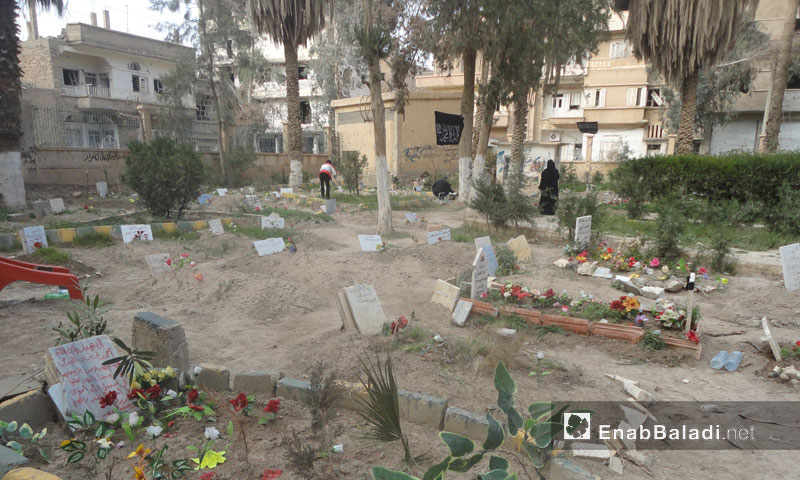“As if exile and loneliness are their destiny,” says Um Mohammad, 51 years old, describing the condition of the tombs in the neighborhoods that were out of the regime’s control, which number exceeds a thousand in more than seven parks, that have been moved by the regime, about 25 days ago, to the city’s major grave yard in the mountain close to it.
The “miniature” tombs, as the people call them, developed a symbolic value among people, including Um Mohammad, the mother of one of the people buried in the al-Mashtal Garden in the Sheikh Yassin neighborhood, from which she departed to the city of al-Tabqah in Raqqa, after the shelling on the city intensified, early in 2017, to be fully controlled by Assad’s forces at the end of the same year.
The tombs were constructed in different locations within the neighborhoods of Deir ez-Zor, the most famous of which are the following: The parks of al-mashtal, Abu Tmam and al-Ommal.
These graves incubated the bodies of the civilians who died in the shelling and the fighters who died on the fire lines, some of whom are from other governorates, in addition to the people who were lucky enough to die du to natural causes in the past seven years.
With a broken heart, the fifty-one years old woman departed with her home, bitterly stressing that she could not pay a visit to her son’s grave because of a restraint order that denies people the right to enter the grave yards, which the “Islamic State” ISIS issued back then, imposing penalties on those who would not abide.
A Loss of Trace
Um Mohammed, with her surviving children, settled down in the city of al-Tabqah, saying that during the reign of ISIS, the tombs were subject to intentional sabotage, for, according to her description, the “Islamic State” attempted to promote the idea that the graves belonged to dead people, “whose faith is questionable.”
She also mentioned that members of the “al-Hesbah” Board, threatened to imprison her last year, when she tried to reach her son’s grave; the “Islamic State has damaged the tombs of martyrs, and bombarded some of them, while it erased the features of others; today, the regime is completing the disturbance process, for it is taking the decaying bodies from the graves to bury them in an unknown location in the mountains.”
Today, “Um Mohammed” cannot do anything but read the al-Fatiha, a verse from Quran, to bestow her son’s soul with God’s mercy from where she is, pointing out that she does not know where her son’s grave is located anymore.
Activists Believe that It Is “Vengeance”
Activist Sulyman al-Amer, 27 years old, from the city of Deir ez-Zor, believes that the regime is keen to move the graves, while it is witnessing its end, is an attempt to revenge from those in the graves, considering that “it is an attempt to erase the history which these heroes wrote with their blood, because the graves remind them of these people.”
The “Islamic State,” which controlled the neighborhoods in 2014, tried to dispense with the graves as symbols, “to annihilated what their residents have presented upon defending their city,” according to the activist, saying that they form a part of the city’s history, which the regime is currently trying to diminish.
The graves are “a proof of the Islamic State and the regime’s criminality against the victims who died in the shelling and the confrontation between them,” according to the activist.
Moving the Graves to the “Right place”
Abu Qasem, 45 years old and one of the municipality’s workers in the city of Deir ez-Zor, believes that the dispute over moving the graves is inaccurate, describing what happened as “moving the remaining graves to the right place in the mountain’s grave yard.”
The municipality staff supervised both operations, the transference and burial, according to Abu Qasem, who considered that “this helps to rehabilitate the public facilities in the city into habitable places,” pointing out that “the parks are a place for rest and for children to play, and it is necessary to move the graves with a total respect to the deceased people, as a humanitarian and a religious duty.”
The municipality worker explains that “the graves were not dug in the correct manner or depth,” pointing out that they were liable to be “uncovered, and their presence among houses, permanently, might lead to health issues and diseases.”
The opinions and narratives differed according to the orientations of the person presenting them; however, many people agreed that the graves are a part of the city’s history and a witness for the things it went through, considering that “any violation of the graves is a condemned one no matter who does it.”
“Diminishing the graves will never erase the memory of the people in them,” according to Um Mohammad, who stress that “we have engraved the names and images of our martyrs in our hearts; neither the extremists nor the regime would manage to obliterate them or destroy the pride, freedom and steadfastness we lived thanks to the people within these graves.”

